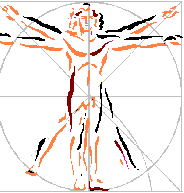Note:
If you are using this model as a prototype, please look at both the objective and
the activities provided for each domain very carefully. In order for a
lesson to qualify as "holistic" there has to be a clear intention,
either in the statement of the objective or in the activities provided, for
growth to occur in that domain.
Area of concentration: Communicative Disorders
District Aim: The student will improve her communication
skills.
Goal: The student will improve her expressive vocabulary
skills.
*Note:
This plan was created before the
development of Wisconsin Model Academic
Standards -- If you use this plan as a prototype for a general class, please
include The WI Standards.
If it is an individual client plan, that is not necessary.
Grade Level: Preschool - This plan uses activities
in all three domains in order to develop more comprehensive
communication skills.
- Cognitive Objective: When presented with an object, the student will identify and produce the
target word with 90% accuracy.
Procedures: Using toys such as dolls, cars and boats, the
clinician and student will engage in free play. The clinician will use
one or two word utterances naming the toys and have the child repeat the
word after them. Verbal praise will be given for all attempts at the right
word. For incorrect responses the clinician will again show the child the
toy and model its name.
- Affective Objective:
The child will choose the three toys she likes best to play with during
a free play activity. She will be asked questions about the toys and why
they might be favorites and then asked to name the toys with 90% accuracy
within the conversation. (Note: Please look carefully at
the activities below. You will see that there is a very clear indication
that, while the child is talking, he/she is also exercising judgment based on
emotional responses. This is why this objective qualifies as
"affective".)
Procedures: The clinician and student will again
be involved in free play, however, the clinician will not model the toys'
names. If the child chooses a baby they will hug the baby and rock the
baby while talking about what they are doing. If she chooses a racing car
they can make it go fast and run it off the table while describing it.
During the free play the clinician will ask the child why the toys are
favored. The child will be encouraged to discuss her feelings about the
toys and name the toys correctly. Verbal praise and encouragement will
be given for the correct use of each toys' name.
- Physical Objective:
The child will use sign language to sign as well as voice the target words
when presented with an object to 90% accuracy. (Note:
Please look carefully at the activities below. You will see that there is a
very clear indication that, while the child is talking, he/she is also
exercising fine motor control signing. This is why this objective
qualifies as "physical".)
Procedures: The clinician will have either toys
or snacks for the child to play with or eat. The child will have to use
their voice as well as a sign for the object they want. For example, if
the child asks for juice, the clinician will give her a just a little bit.
That way she will have to ask for more, again using sign language and voice.
Verbal praise and tangible rewards are given for correct productions.
Here
are some links to areas in other portions of this website related to planning.
Next set of holistic plans


